
by Fred Brewer | Nov 15, 2019 | Need To Know
Today we’re picking the brain of our Lead Account Manager and Google Ads Specialist, Christian Rodriguez, and doing a quick dive into a question we get asked all the time: How do I get my business to show up in Google Maps? We’ll be talking primarily about the local pack (the three businesses that show up whenever someone does an organic search on desktop or mobile).
Ready? Let’s do this.
What does Google use to rank businesses in Maps?
When talking about Maps rankings, there are really three key things that Google uses to rank businesses:
- Proximity.
- Relevance.
- Prominence.
Ranking factor #1: What is proximity?
Proximity is the #1 ranking factor in Google Maps. When I say proximity, I mean proximity of the business to the searcher. It used to be that years back, the closer you were to the center of the city or town that you wanted to rank for, the better you would rank for those types of searches.
That is really no longer the case, unless you’re trying to do a search from somewhere else. But that’s really more of a vanity search than anything, because really your customers that are in the areas that you serve could be a mile away from you and see a completely different set of results.
What matters now is how close your business is to the searcher.
Can you influence proximity?
There are a couple of things you can do to sort of influence or contend with this ranking factor.
#1 Open an office in the location where you want to rank.
This first one is highly impractical, but if you have the resources it can be done.
In the past, you could use home addresses to open a separate office, but more and more, we’re seeing that be less viable. Unless you have signage outside of that home address and it’s an actual home-based business that could potentially have customers visiting that location, we don’t recommend doing this anymore.
The more legitimate the business appears, the better for you. And obviously the best way to do this is by having a physical storefront that has signage that’s easily visible from the street.
#2 Use Google Ads to expand your proximity.
You can actually use Google Ads to sort of expand your proximity. This is not just useful for organic search, but again, for Maps as well.
One thing to consider is that you are going to need to set up a location extension on your Google Ads, which means you are going to have to show your main location and advertise that location in order for your Maps Ads to run. So there is that component to it.
#3 Make sure you rank in organic search.
As we talked about, opening an office can be quite expensive and requires a lot of resources, so if that’s not an option for you, focus on your organic rankings.
If you have a city page on your website for the city you want to rank for, and it’s ranking organically, that can help you reach customers in areas that are a little bit further out. Sure, you’re not going to be at the very top with those three businesses in the local pack, but a lot of people do scroll down and look at at least half of the first page, if not the full page of search results. So you still have an opportunity to capture some of those searchers.
Ranking factor #2: What is relevance?
Moving on to the second ranking factor, we have relevance. And when we talk about relevance, that is:
- Are you offering the services that the searcher is looking for?
- Are you in the areas that the customer wants to get serviced?
The more your business can relate to the searcher based on information that’s on your Google Business Profile and the information that’s on your website, and the more relevant the search query is to what it is you offer and the information that’s contained on your website, the better chance you have at hitting relevance.
Can you increase your relevance?
There are a few things that drive relevance and can help you increase your relevance in Google’s eyes…
#1 Have the right Google Business Profile categories.
When you set up a business listing in Google Business Profile, there are a number of categories to choose from, and they’re constantly updating these categories. For example, ‘chimney sweep’ and ‘chimney services’ are two categories that are available.
If someone is searching ‘chimney sweep’ in say, Nashville, TN, and your primary category is ‘chimney services,’ you’re not going to be as relevant as if you had ‘chimney sweep’ in your primary category or ‘chimney sweep’ in one of your additional categories. So it’s very important that you add any and all categories that are relevant to your business.
Obviously, you don’t want to go too crazy with this and add categories that are just slightly relevant, but if it’s a core service that you offer and it’s listed in the categories, I would definitely add that in without spamming it too much.
#2 Have your keyword(s) in your business name.
Hopefully as Google gets smarter, this will become less of a factor, but if you have the keywords ‘chimney sweep’ or ‘chimney services’ as part of your business name, you’re likely to rank better for those keywords because it’s relevant to what someone is searching for. This is something that’s really frustrating, but it’s something that unfortunately still works.
#3 Have keywords as images on your Google Business Profile listing if possible, and make sure your images are optimized for your top keywords.
We’ve seen more and more that Google is starting to become really smart at figuring out what is in an image without you specifying it. But nonetheless, we still recommend you name your images in a way that targets your keywords.
A quick way to do this is, when you upload an image to Google Business Profile, name the image in a way that includes the relevant keywords. For example, name it ‘technician sweeping a chimney,’ or ‘chimney being repaired.’ That’s a quick way of adding in some more relevance and speaking to what the photograph is actually about.
#4 Whatever page you have linked to in your Google Business Profile, you want to make sure that page has keywords containing your main services.
On your Google Business Profile, you’re allowed to include a link to a page on your website. Whatever page you choose, make sure it has some of those top service keywords in the content.
For a chimney sweep, the big ones that typically are true across the board are chimney sweep, services, repairs, masonry work, and maybe even dryer vent cleaning. So if you have all those listed somewhere on your home page, if that’s the page you’re linking to from your Google Business Profile, chances are that when someone is searching for those services, you’re going to have those relevant factors there.
#5 Get good local links.
Another thing that’s going to drive relevance is local links. If someone is searching in a specific zip code for a service, and a local news outlet wrote a piece about you or mentioned you in one of their stories or articles, then Google sees that and it shows them that you’re in the area and you perform these services, so you must be a relevant search result.
That’s another big one that is a little bit harder to get, but if you have those relationships with your local community, you might have a chance at getting some good local links.
#6 Get your customers to mention keywords in their reviews.
I know it’s hard enough to just get someone to leave you a review, but if you manage to convince customers to not only leave you a review, but to leave you a review with the service you performed mentioned in it (for example: ‘So and so was great. They did a great job of sweeping my chimney.’), then all those keywords speak to that relevance and all of that information is on a Google property (your Google Business Profile). As a result, Google has that information and is able to build a suite of different offerings that you have, and it’s verified by other people. So again that contributes to your overall relevance.
Ranking factor #3: What is prominence?
The last ranking factor for Google Maps is prominence. Prominence is:
- How well known you are
- How big your company is
- How visible you are in your community
That sort of thing.
How can you improve your prominence?
#1 Reviews.
One thing that’s going to drive prominence is, of course, reviews. The more reviews you have, the more prominent you’re going to seem, and typically the more prominent you are.
#2 Online mentions.
Another thing that’s going to be pretty important here is, again, very similar to relevance: online mentions. You want these to either be from local businesses in your area or just from other websites from the same industry.
So, for those of you that are CSIA certified, you have an online mention there. They list the technicians that are CSIA certified and the company, and they add a link to the company website from their website. That’s just one example, but obviously the more certifications you have, the more chances you have to get some of these online mentions.
Some other examples:
- If you are in your local Chamber of Commerce, that’s an online mention from a local source.
- If someone links to one of your articles or something that you published on your website or blog and they’re in a similar industry — maybe they’re another chimney business, a home restoration website, or a fire prevention website — that online link/mention will drive your prominence.
#3 Brand awareness + brand searches.
Another thing that Google looks at when it comes to prominence is brand searches.
The more well-known your brand, the more searches there are for your brand directly. Google picks up on that and says, ‘Hey, you know, this one company has a lot more searches for their name than all these other companies. They must be a preferred company in the area.’
Building your brand awareness is huge, and that’s a big component of prominence.
#4 Citations.
Citations are places where your Name, Address, and Phone Number (NAP) are mentioned online. Now, over time, we’ve seen citations kind of lose some of the strength they’ve had in the past. So for citations, what I would say is have your main citations up to date with the correct information. Consistency is more important than quantity for driving prominence.
Some of the biggest citations include your Facebook business page, of course your Google Business Profile listing, your Yelp listing, and Angie’s List, if you work with them at all.
Other important citations will vary from market to market, but if you do a branded search for your business, you want to make sure that any citations and listings that show up on the first two pages of search results are up to date.
#5 Community involvement.
And really the final thing here is going to be more offline than online: get active in your community!
The more active you are in your community, the more networking you do, the more prominent you’re going to appear to be — simply because if you sponsor events and local little league teams, chances are they’re going to post about it. If it’s not on their website, it’s going to be on their Facebook page, and so that drives that community awareness.
In turn, more people are more likely to search for your company name directly, especially if you have a memorable one. They’re going to search for your company name as opposed to making a generic search like ‘chimney sweep near me.’
And not only are you getting people coming straight to you instead of going to the marketplace, but also, again, Google sees that number of branded searches increase, and that’s going to drive your overall prominence.
Caveats & Considerations
One thing to kind of note is that Google Maps and the local pack were originally set up for brick-and-mortar, physical locations. Service businesses have always been at a disadvantage, especially if they don’t have a location that can be shown — and that’s still the case at the time of the writing of this article.
Hopefully, in the future, Google will recognize that being 10 miles away isn’t as relevant to the searcher if they’re searching for a plumber or a chimney sweep versus a restaurant or retail shop. Personally, it doesn’t bother me if a plumbing company is 30 miles, or even 50 miles away. If they’re the best and they come to my area, I want to call them as opposed to whoever is closest. But for now, that’s kind of the world that we have to play in unfortunately.
Another thing to note is this all varies widely depending on your market and your competition.
The more saturated a market is, obviously, the more proximity plays into effect. Because there are so many companies fighting for a spot and they’re all close together, really the closest ones to the searcher are going to be shown, and it’s going to be harder for someone that’s just a little bit further out to show up for that search.
Also, the more saturated the market is, the more likely it is that some of the other companies in the area are doing a good job with relevance and prominence. So just note that this may vary depending on your market and how saturated it is.
Wrapping Up
Hopefully that gives you insight into how Google ranks businesses in Maps and what you can do to improve your ranking, even though you might not be all that close to the searcher.
Proximity isn’t something we can’t really change a whole lot, but by increasing your relevance and your prominence, you have a better chance of ranking, even if you’re a little bit more removed from the searcher.
Thanks Christian!
Pssst. If you’re a client and you want to know more about any of this or you want specific help on what you can do in your specific case, definitely reach out to us and let us know. That’s what we’re here for!

by Fred Brewer | Jun 15, 2019 | Need To Know
Google. For the average searcher, it’s a noun, a verb, and a godsend that makes everything in life just a little easier. But for a small business owner, it can be a word that brings on rants and feelings of anxiety, victimization, and anger. After all, It’s Google’s game. Google makes the rules, Google changes the rules, and business owners are often left to figure it out, without much of a rule book.
But the reality is: You gotta play ball somewhere. And if you play with integrity, stay on top of the changes, and anticipate the next move, Google can be a really good thing for your business.
Google Brings The Crowd
According to Statista, Google accounted for about 62.5% of all search queries in the U.S. in January 2020. That means if you’re not making your business visible on Google, you’re not sticking it to Google, you’re sticking it to yourself.
Whether at home or out and about, people are searching for local businesses on their phones, and apparently the majority of them are using Google as their preferred search engine. So, you need to make sure you’re bringing your A game and playing on Google’s field, because Google’s bringing the crowd..
Covering Your Bases
So what does bringing your A game to Google mean? What are some plays that can help you win, even though it’s not a home game for you?
Google Business Profile
Claiming and managing your Google Business Profile is one of the easiest and most important things you can do when you’re playing ball with Google. This is essentially your in-search website, and Google wants it to provide searchers with all the basics, like your phone number, your address (if you have a business people can visit), your hours, the locations you serve, your website URL, and your services.
There are new features coming and going all the time (like Google Posts, Q&A, etc.) so don’t just look at your Google Business Profile once and leave it at that; get the app and check it regularly to make sure everything’s up-to-date.
Google Posts
Speaking of your GBP listing, you can add Google Posts to that area, including photos and videos. It’s a (currently) free way to easily showcase your work, your employees, and your specials, and put a little extra personality and incentive in front of searchers who are looking at your business, but haven’t yet clicked through to your website. Posts are super easy to do — you can literally throw one together on your lunch break.
Reviews
Even though Google has a bit of a fake review problem, the need for great, authentic reviews hasn’t waned. 82% of people look at a business’s reviews before making the call or visiting the website, and with Google showing the star rating right in your GBP listing or in Maps results, it’s an easy(ish) way to make yourself stand out. So make review generation a routine part of your service, by using tools like GatherUp or implementing other tools or strategies.
Google Ads/PPC
You often hear that it’s a pay-to-play world online these days, and while that’s not your only option, it is a good option. Adding Google Ads to your marketing strategy can help get your business out in front of more eyes, and since Google Ads get favored placement in Search Engine Results Pages (SERPs), people on mobile don’t even have to scroll down to find you.
Ok, ok, but isn’t it incredibly expensive? It all depends on your market and competition. Google Ads uses a bidding system, so if you have some big competitors and you’re in a super saturated market, it can be hard to compete with those bigger budgets. But that’s not always the case. There are other factors that determine which ads get shown other than just the highest bidder.
If you’re curious about Google Ads and want to see if they might be a financially feasible option for you, give us a call. We can take a look at your market and competition, and figure out if it’s something that would work with your budget.
Google Local Service Ads
Google Local Service Ads are ads that show up even above traditional PPC ads, but they’re not fully rolled out to every market and every industry. They’re also a little bit different from traditional ads.
These feature a “Google Guarantee” badge, and Google has also tested a “booked X times near you” feature. The point of both is to encourage people to feel confident in choosing the business, because they know 1.) Google vouches for the business 2.) Everyone else is doing it.
While Google Local Service Ads are still new-ish, a lot of people are seeing great results and finding that the average cost-per-click is actually lower than that of Google Ads. But these ads come with additional rules as well, so be sure to get the run down before you get started.
Organic Search Results
While Google Ads and Google Local Service Ads (if they’re rolled out in your vertical and in your area) take up a lot of space on the tops of the SERPs, they’re not the only places people are looking and clicking. In fact, according to the latest BrightLocal Local Services Ads Click Study, organic search results still account for the most clicks, even when Google Local Service Ads are present. In other words, organic still matters.
So how do you make sure your bases are covered here?
- By making sure you have accurate and consistent listings created for your business on all of the relevant players. That means places like Google, Yelp, Facebook, the Better Business Bureau (BBB), and niche sites related to your industry. If you’re in home services, for example, you may want to have listings on Angie’s List, HomeAdvisor, Porch, and similar sites.
- By making sure your website is well-optimized, mobile-friendly, and filled with relevant content and keywords. Google’s slightly obsessed with E-A-T (Expertise, Authority, Trustworthiness), and it will look at things like the quality of the content on the site and the bounce rate of searchers that visit your site to weigh in on that. It’s also important to have authoritative links pointing to your site, especially local links if you’re a local service business. Obviously, you want to get these links naturally, so get involved in your community, sponsor events and local sports teams, and look for link opportunities.
The Highlight Reel
Playing ball with Google may never be as fun as real baseball, but don’t throw down your bat and sit this one out. You can’t afford to. Pair up with a marketing company that watches Google’s every move, has studied every hypothetical playbook, and can signal you when you step up to the plate. With a little help and a little focus, you’ll knock it out of the park, and win on Google’s turf.

by Fred Brewer | Sep 15, 2017 | Need To Know
One thing we love about the chimney sweeping industry is the sense of community and the willingness to lend a hand to those in need. That’s why it was no surprise to us that Tommy Nelms and Mark Stoner (two rockstars in the chimney industry) started Sweep Away Cancer, a 501(c)3 non-profit that raises awareness and funds for breast cancer research, and aids those in need.
Every October since the non-profit’s inception, chimney sweeps from all over join the movement and do their part to sweep away cancer. Are you and your team ready to raise awareness and help find a cure? Here are some ways you can get involved this October:
- By purchasing and wearing pink “Sweeps For A Cure” shirts, which spark conversations and help to raise awareness with customers. Let your customers know you care and that you’re working hard to make a difference in the lives of those who have battled or will battle this disease.
- By leaving behind pink “Sweep Away Cancer” koozies at the end of every service. Think of it as a little “thank you” gift for your customer that gets the conversation going and lets your customer know you care about the health and welfare of women (85% of customers in the chimney industry are women).
- By asking customers if they’d like to donate to the cause. Once you get the conversation going, your customers may want to get involved. If customers inquire about how they can help, you can either take donations yourself or direct them to the Sweep Away Cancer website, where they can donate directly.
- By donating a portion of sales from the month of October to the movement. Many companies choose to take a portion of profits from the month of October and donate to Sweep Away Cancer. Letting customers know that your company participates and initiates change in this way will make your customers feel good about spending money with you, because they’ll know that some of it goes towards curing cancer and helping those fighting the disease.
If you’d like to learn more about how the foundation was started and how you can get involved with the Sweeps For A Cure movement, or to purchase “Sweeps For A Cure” shirts for your team or “Sweep Away Cancer” koozies for your customers, visit the Sweep Away Cancer website. There, you’ll also find some of the best resources and research websites so you and your team can go into Breast Cancer Awareness Month educated and informed.

by Fred Brewer | Jul 31, 2016 | Need To Know
In our last post, we sat down with Tom Smodic to discuss Google’s rapid rollout of changes. This week, we’re going to lay out a few of those changes and what we think they could mean for local businesses.
Disclaimer: Google is the King of leaving things open and somewhat vague, so none of this is meant to be a definitive take on Google’s action or intent. A lot of research, testing, and reading between the lines is required when Google is involved, and we’re simply passing along what we see and our inferences based on what we see. Enjoy!
Google Business Profile Joins Twitter & Facebook
Google recently announced that they will now be providing Google Business Profile (formerly GMB) support to users via social media (namely Twitter & Facebook Messenger). As long as you are tweeting or messaging during regular support hours, you can expect a prompt, knowledgeable response.
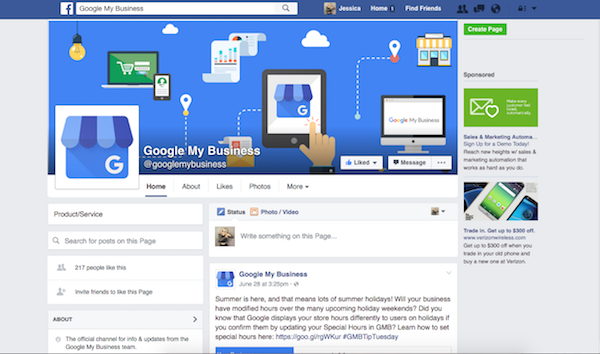
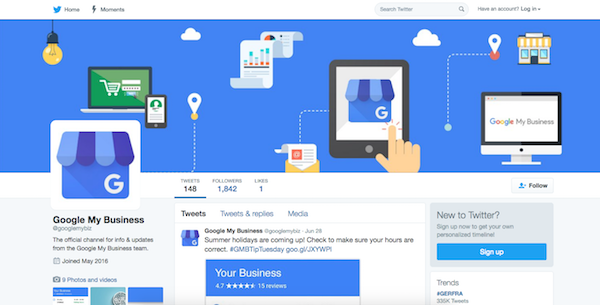
Why?
Let’s face it, if anyone knows users want fast results, it’s Google. This change could be an effort to simply provide a better user experience and faster resolutions to problems and issues. Why Facebook and Twitter? As Tom mentioned in our previous post, you have to go where the people are. Offering support to users through multiple channels, not just their own, shows that even Google knows this to be true.
Of course, this change could also have come about as a result of user feedback. People may have been asking why swift Google Business Profile support wasn’t available through social media channels and Google may have decided it was a worthwhile venture.
Whatever their reasoning, we see this as being a good thing that will hopefully make receiving prompt support easier and less agonizing.
Google’s Testing Video Verification
GBP has announced it is experimenting with video calls for business verification.
Why?
For as long as we can remember, one of Google’s main business verification processes has involved waiting for a post card to arrive by snail mail. Once it arrives, you enter the pin online where prompted and your business is verified. The problem is, snail mail is anything but fast and reliable, and sometimes the post card never arrives. In many cases, the business owner doesn’t finish the process and these pages don’t get verified.
Now, however, you can simply do a video call with a Googler to get the verification ball rolling. On a forum, a Googler mentions that, although you’re under no obligation to try this new method of verification, they hope “you’ll find it quick and convenient.”
So, perhaps video verification is Google’s attempt to cut down on spam and encourage business owners to complete the verification process by making it easier and faster. However, the video call must be conducted from either your workplace or your vehicle, which some business owners might find invasive. You’re encouraged to show your workspace, logo, and even the tools you use to the Googler (if you video verify from your workplace), and show your license plate, tools, and business logo on your vehicle to the Googler (if you video verify from your vehicle).
We have a feeling some business owners will be hesitant to verify using this method, and it seems that Google might have the same feeling. The Local Search Forum states:
“Not excited about video verification? If you’d prefer to not take part in our video experiment, please let us know. (We’ll wait to hear back from you before taking any further action.)”
Again, we think this new verification option is perhaps partially designed with the user in mind and partially designed to reduce spam. After all, it’s hard to spam with video, especially when you’re showing the Googler around.
Google Has Introduced Paid Ads to the Local Pack
For a while now, we’ve watched the local real estate in search results shrink. The local pack has gone down from a 7 pack, to a 5 pack, to a 3 pack. And now, one of those 3 is a paid ad.
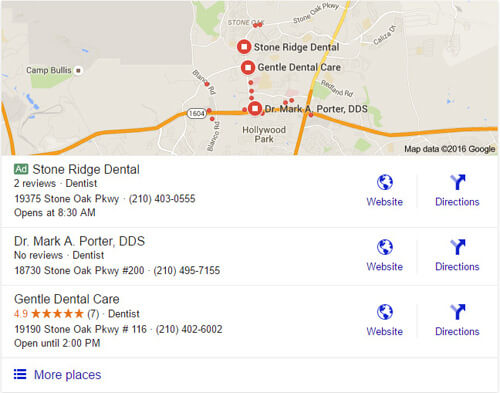
Why?
Money! Google isn’t just a search engine, it’s an advertising platform. Like any business, they want to make money! And with the end goal of creating a seamless experience across mobile, tablet, and desktop, they’re dealing with less screen space in which to place those ads.
Honestly, we’re not all that surprised that this happened, but it does give local businesses without the budget for ads a disadvantage by removing 33 1/3% of the local pack space. (It’s ok Google – we’re not mad, we’re just disappointed.)
Now, perhaps more than ever, having a constant influx of good reviews is vital. For more on this Google change and what we think it means for your business, read our interview with Tom Smodic.
Paid Ads Appear in Google Maps
Just as we’ve seen paid ads enter the local pack, Google has also rolled out paid ads in Google Maps.
On desktop, Google maps shows these ads in the list of search results just to the left of the map, as well as on the map itself. You’ll see a purple icon (indicating the ad), and if clicked on, the ad will display more information (such as a Directions button and business details).
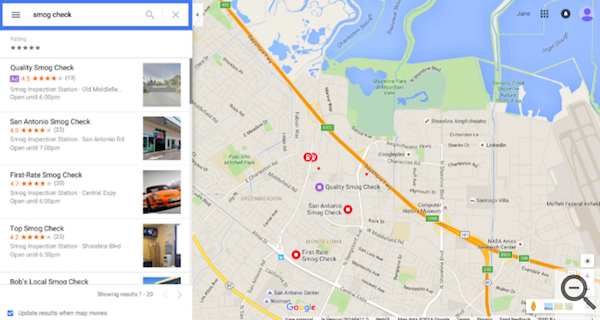
On mobile, the ad will appear on the map itself and on the list below the map. Once again, a purple icon will indicate that this is in fact an ad, and if clicked on, you may see things like a Call button and a Directions button. Your ad can also reveal things like customer reviews and hours, if clicked.
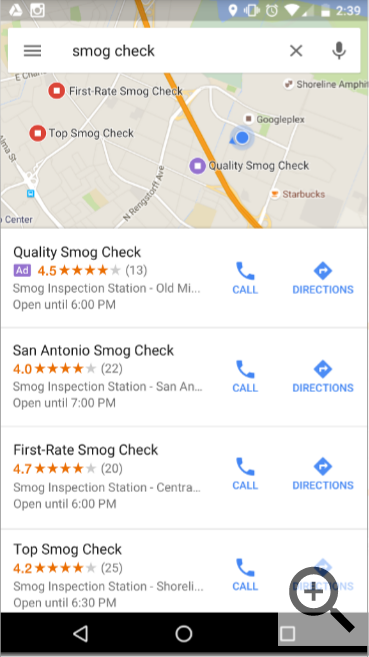
Why?
We see this as an indication that Google is paying more attention to brick-and-mortar businesses. And considering how many people are using Google maps, it’s no surprise that Google has decided to monetize (to a degree) this area of search.
Whether you decide to pay to play or not, make sure your map listing is right! Nearly one-third of all mobile searches have local intent, and if your map listing is incorrect, you’re going to miss out on business, especially if you have a brick-and-mortar business.
Change Is Inevitable
These are just a few of the changes that Google has rolled out lately. Although we can’t tell you exactly what Google will do in the future, one thing you can count on is for us to watch with a close eye and stay on top of these changes. And remember, even though you can’t control what happens in the world of search, you can control the value you deliver to your customers. So get out there and give them your best!

by Fred Brewer | Jul 15, 2016 | Need To Know
It’s no secret that things are always changing with the Wild Wide Web, but if you feel like changes are happening at an accelerated speed as of late, you’re not alone. This week, we sat down with Tom Smodic, our Marketing Manager and former Lead Account Manager. His chosen week of vacation this summer just so happened to align with one of Google’s biggest recent changes: the addition of an Ad to the local pack. We’ve asked him to talk about how fast things are changing and what this change means for small business owners. Here are some of the highlights.
Tom: I was gone a week, and the biggest change I saw was that Google started to monetize the local pack, which is different than organic and different than Google Ads.
For those of you who don’t know, the local pack, which is an area specifically reserved for local businesses, was at one time a seven spot, then five, then three. Now, for all intents and purposes, it’s a two spot.
Tom: Two out of the three are based on whatever algorithm Google has for local service businesses, but then the third can be paid. Whether that’s going to impact people’s decision-making has yet to be seen because it hasn’t fully rolled out yet. Are people going to care that one of these is an Ad or are they just looking to see where things are located?
Were you surprised that Google took this step and sort of crept into the local pack space?
Tom: It was not so much a shock, not so much a surprise. We’ve seen Google looking at how to change that space, whether it was the “Request a Contractor,” “Request A Quote,” and things like that, or things like this. They’re always looking to deliver results. But what you have to remember is that Google is a Search Engine, but they’re also an Advertising Platform, and they’re in it to make money. They’re not in it for altruistic reasons, they’re in it to make money. And if they find a way to do that without disrupting everything that they’ve kind of built their reputation on, they’re going to do it. So, I think we’re just seeing that trend continue.
Do you think this trend has picked up any momentum or simply remained steady?
Tom: I think it’s accelerated since I’ve been working here, just the amount of changes. They’re looking to do some more things in real time, like updates and search results, as opposed to set updates and stuff like that. It’s not that you’ll have a change like this every week, but Google’s always looking. And it’s not like there’s going to be a huge announcement or anything like that. You’re not going to get an update on your phone telling you what happened, it just kind of does. And it’s up to us to stay on top of that as best we can so we can answer the questions that may come up from our clients. That’s part of the ongoing day-to-day thing that a lot of people don’t realize. Because it’s changing, we have to stay on top of the landscape. If we stopped reading two years ago and just said, “Well, we know how this works,” or “We know what we’re doing,” we’d be in trouble because a lot of it has changed since then. We have to keep up to date. I just happened to pick the one week where Google made a significant change, though it’s yet to be seen if people will even notice or care.
Until we see whether this affects people’s decision-making when searching for local services, what advice do you have for business owners?
Tom: It still boils down to having good reviews. If you’re running your company well and delivering good service – from the first phone call that the customer makes to your company to the final follow-up and anything beyond that – if you’re delivering the right customer service to them and are friendly, don’t overcharge, or do those things that customers don’t like, they’ll be more inclined to leave a good review. And you won’t be scrambling to keep up with somebody and keep reviews fresh. It all comes back to that. Are you delivering value to your customer base and are you doing a good job of it? Whether it’s online or offline, your customers are going to talk to people – whether they leave a good review or they go tell their neighbor. Run your company well and make sure your customers are satisfied. Let them know that you appreciate their business and that you’d really appreciate it if they shared their experience by writing you a review on Facebook or Google.
Unfortunately, most people aren’t going to just write reviews unless they’re dissatisfied, so you’ve got to ask. And believe me, reviews matter! BrightLocal just conducted a survey and showed users a mock-up of the new local pack with an Ad. The third business got more clicks even though it wasn’t first in the pack. Why? Because it had good reviews!

Do you think a lot of the reasoning behind the acceleration of changes has to do with mobile?
Tom: Yeah, I think mobile is the reason for it. When I started, mobile was there, but there wasn’t that big of an emphasis on it. Google’s trying to create the same experience across both desktop and mobile. Searching on mobile, you’re looking for more real time results, especially when you’re looking for gas stations, places to eat, and things like that. Google knows they have a limited window to deliver the right service to the right person at the right time. So, whether it’s paid for or it’s just through organic search results, they know they have to get it right sooner. Whereas on desktop, it may be a little less time-sensitive.
But not only that, there’s less screen space with mobile. There’s just not as much real estate and they’re trying to put the most relevant result in front of the right person at the right time. So yeah, I think mobile plays into it and probably rightfully so. I don’t think desktop’s going to go away any time soon, but for these types of searches, time-sensitive searches, people on the go, Google knows they have to get it right. And I think that trend’s only going to continue.
Do you think we’re headed in the direction where business owners are going to have to invest in both organic and paid search?
Tom: I think there’s going to be a time when that is true, especially for the smaller guys. How much will need to be invested in paid, I’m not sure, but I think, just with the way Google’s moving, it could end up being a full front page of paid search results. That could just be it. Now whether or not, as that happens, people start to distrust the results is yet to be seen. Again, people might not even care. So, I think it kind of depends on where you’re located and your market. Every market is different. I think the thing to keep in mind is, people are not buying services or products from a company or a brand even, they’re buying from people. So, yes, you want to show up and you want to be in search results, and there might be a time where you have to pay for that, but there’s a lot that you can do offline. Like I said, focus on your systems, focus on your processes, focus on the people that you hire, because you can control those. You can’t always control Google’s algorithms – people think we can, but unfortunately we really can’t. Though I wish we could!
It’s hard to say what Google will really do, but the latest changes just suggest they’re looking to make money in any way they can. Just like any other business, you kind of have to adjust to where your customers are. But for people to go to another Search Engine would take a colossal fail on Google’s part – they’d have to really screw up the user experience to drive people away at this point.
However, I do think more people are going to start looking for businesses on Facebook, Yelp, Instagram, etc., in addition to Google. They’re going to look in multiple places to research a business beforehand. I think they’ll look to local groups and within local communities, paying more attention to the local area and wanting to stay within local. And that’s an advantage that local service businesses have that big brands don’t – they’re more personable & approachable, and you can leverage that by being a part of the community, being visible, being active.
Establish your brand and put yourself out there in your community so that people know who you are and want to do business with you specifically. It’s more than TV commercials and radio – be a resource for those in your area, sponsor little league teams, refer your customers to other local businesses.
There are ways it can be done, but I think in terms of pure search, there might be a time where you do have to allocate some funds for paid search. But then, what do you do after? What’s the experience like after the person finds you? I mean, these are the things you need to think about. They can find you, but if you have bad reviews, no reviews, or are perceived to provide a bad customer experience, then they’re going to go to somebody else, regardless of how far up or down on the first page of search results you are.
Even if you get lucky and capture that click or phone call because you’re first in organic and first in the maps, if the person picking up the phone has the wrong tone, you could lose the customer that way. So you have to be cognizant from the very beginning, all the way to the end of service, and be consistent. Like I said, you might get that click or that call, but what happens after that is ultimately in your control and will determine if they do business with you and come back to you. If you’re in business, you’re in the people business, regardless of your industry. Search may change, but that’s not going to change
So, we’ll just have to wait and see with Google.

by Fred Brewer | May 15, 2016 | Need To Know
As the business owner, you probably like to have things done a certain way. But as your company grows and you bring on new people and start delegating some of the work to others, how can you be sure that things are done properly and to your standards? It’s a common problem that many business owners face, but the answer is simple: create systems.
Is it worth it? You bet.
Creating SOPs (Standard Operating Procedures) and implementing systems now can save you hours in training and prevent dozens of sleepless nights. As long as everyone follows them, having systems in place can safeguard your business against many snags and hitches and prevent disgruntled customers, expensive mistakes, time and material loss, and an inconsistent or unpleasant brand message.
Plus, when something fails or goes wrong in your business, you’ll know that either the system failed you or you failed the system, and it should be easy to determine which it is. This alone can save you time and frustration so you can get right down to fixing things and preventing future problems.
What to Do When the System Fails
Facing a challenge? Did the employee or employees involved follow the system to a T? If so, there’s a problem with the system itself. Revisit the steps and procedures, and ask for input from your employees. Listening to the guys and girls out there doing the work can help you quickly pinpoint flaws in the system so you can make the necessary improvements and changes.
Once you know how the system needs to be revamped, revamp it!
What to Do When You Fail the System
Did the employee involved scrap the system and do things his or her own way? Like anything else, a system can only work if you use it. All of your employees should know the importance of following the systems you, as the business owner, have put into place. If you have an employee that’s unwilling to follow a particular system, ask him why – and really listen.
Maybe he or she has a better way of doing things. If so, you can work together to improve the system for the benefit of the entire team. You can also use this opportunity to encourage employees to come to you with suggestions and concerns instead of overriding the systems you’ve put into place.
The Added Bonus of Establishing Systems?
Need another incentive for establishing systems? With systems, you will enjoy more time and freedom. If you know that the systems work and you trust the employees you hired to follow them (If you don’t trust your employees, you’ve got bigger fish to fry), then you can step away from the office, without worrying about your business crashing to the ground.
And what business owner doesn’t fantasize about having more time and freedom? So get started!










